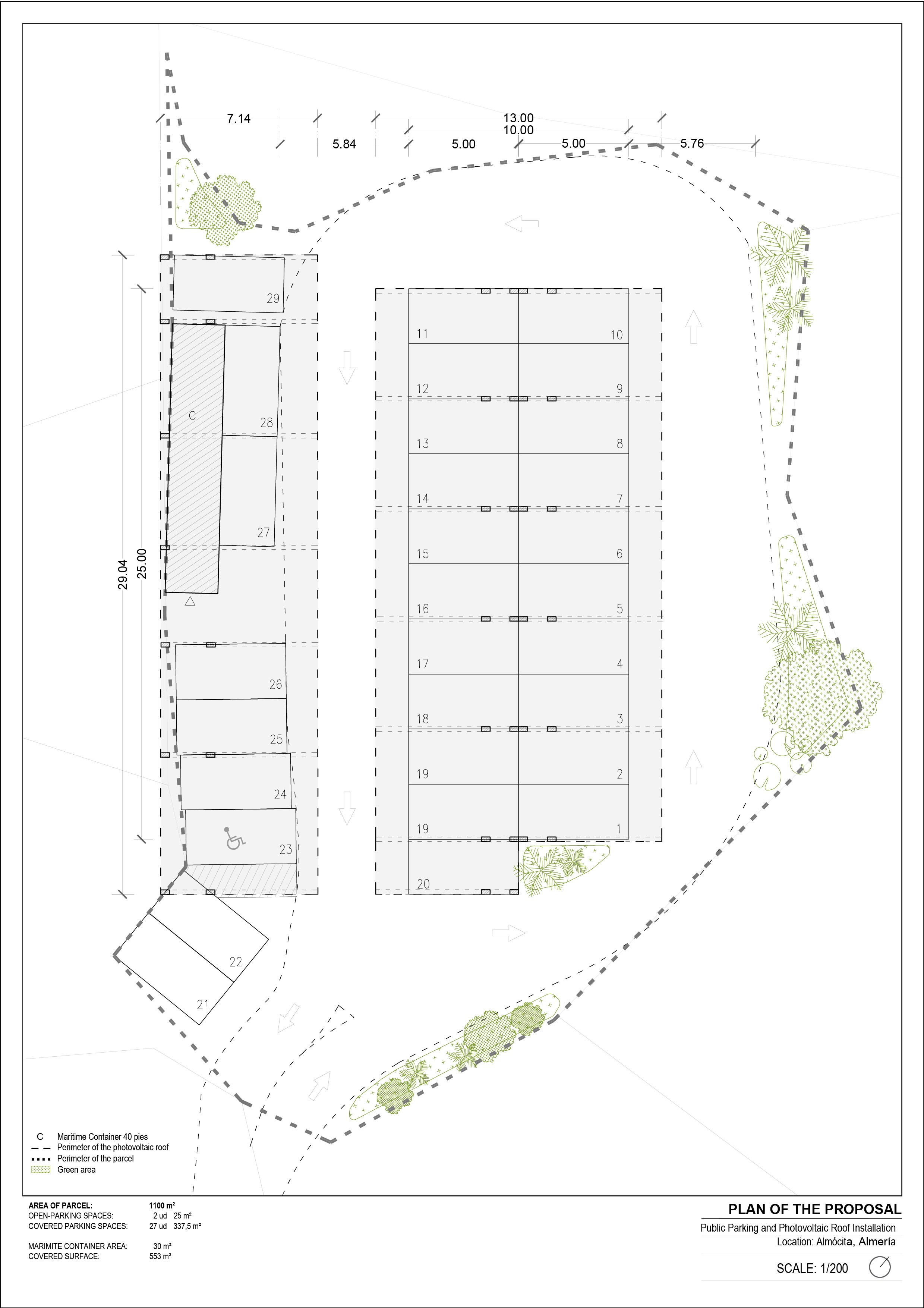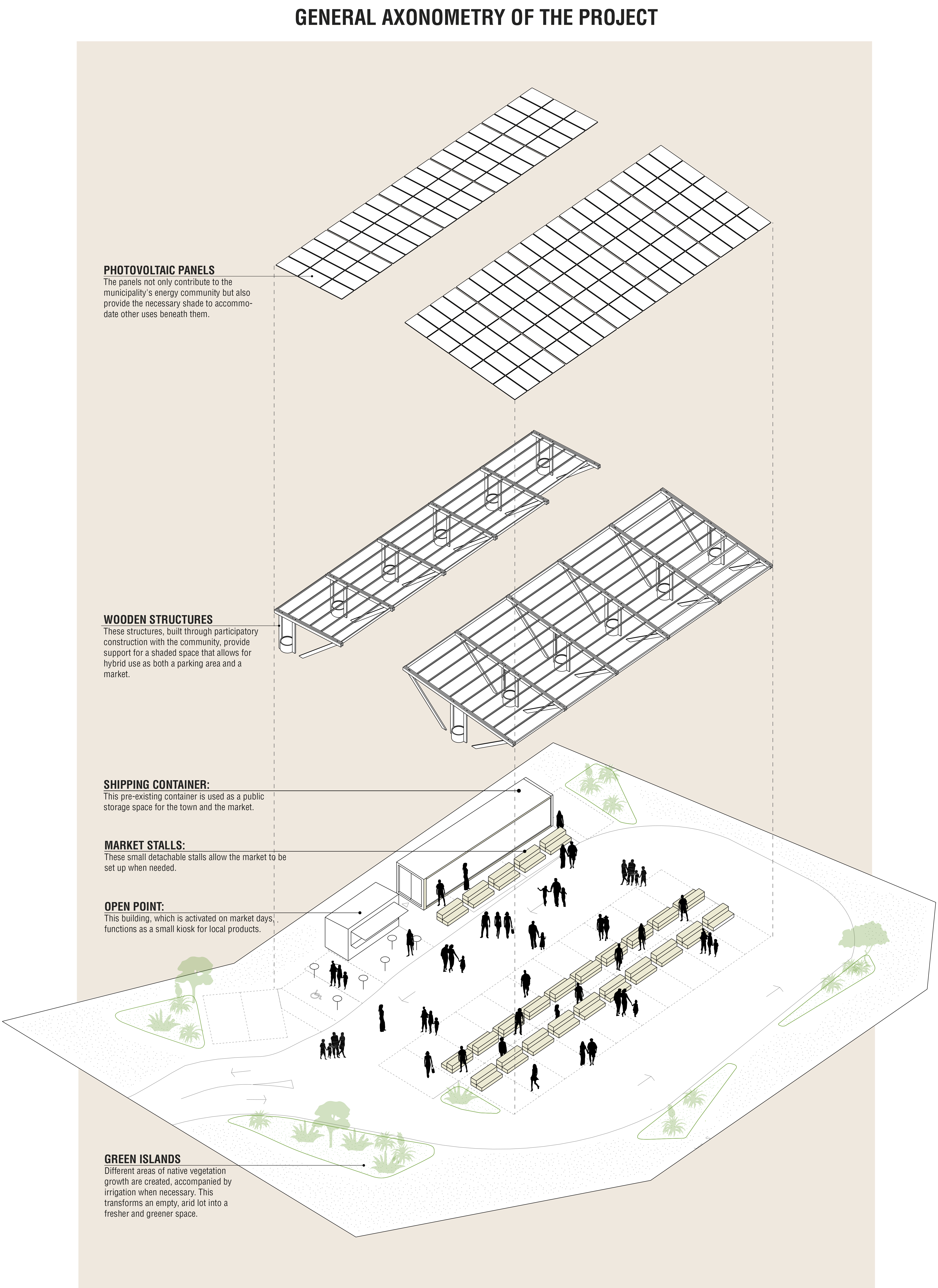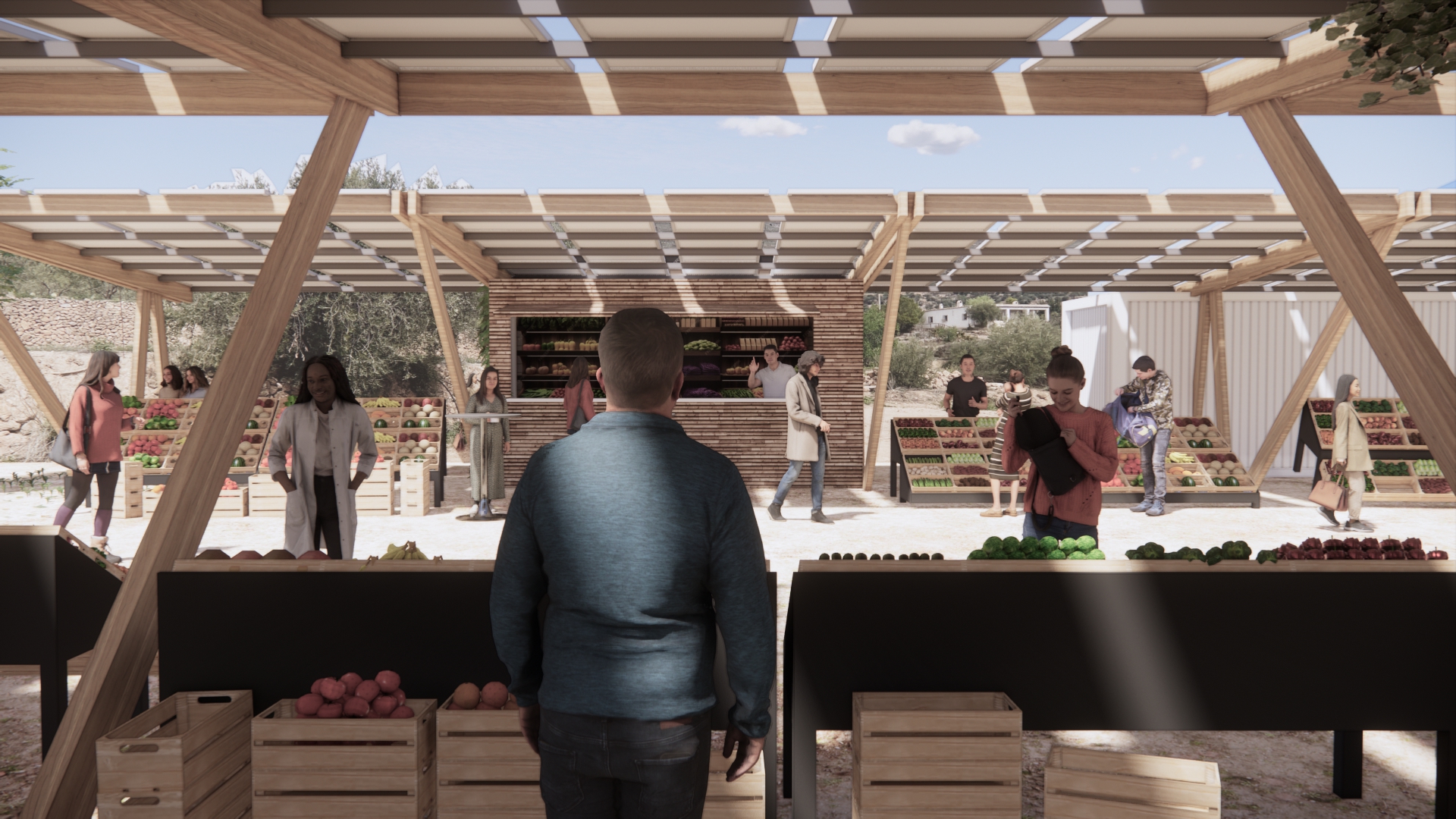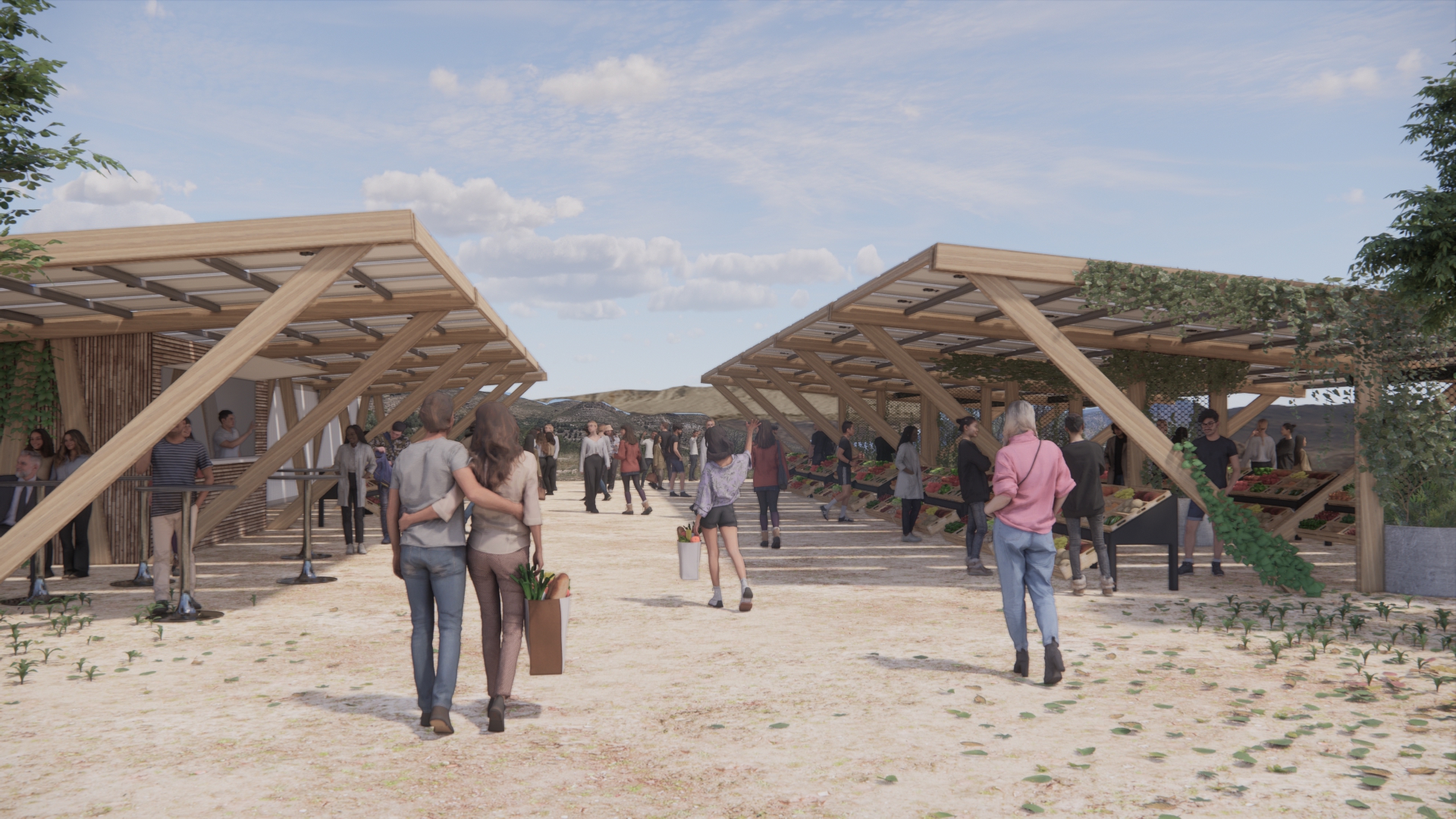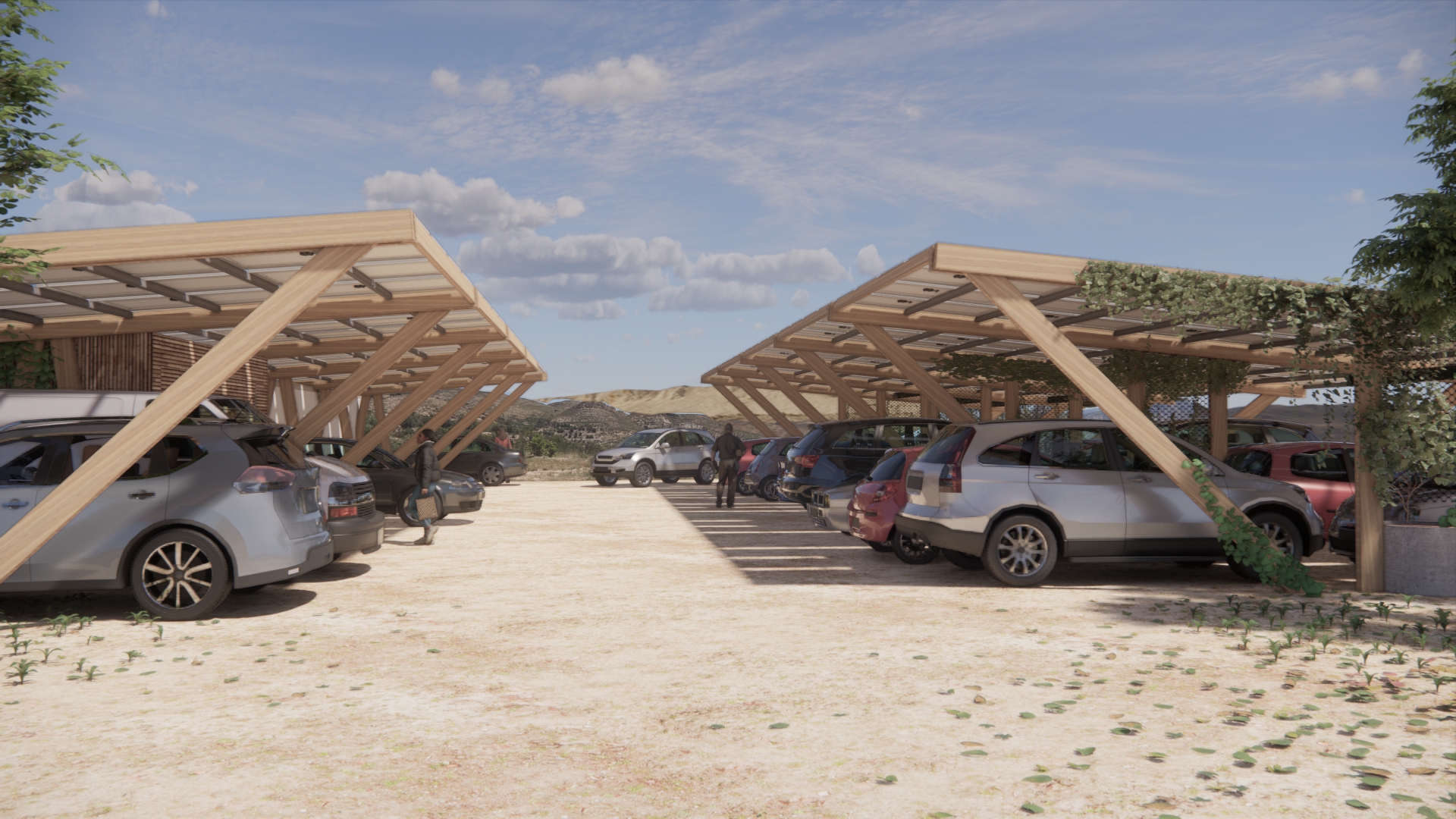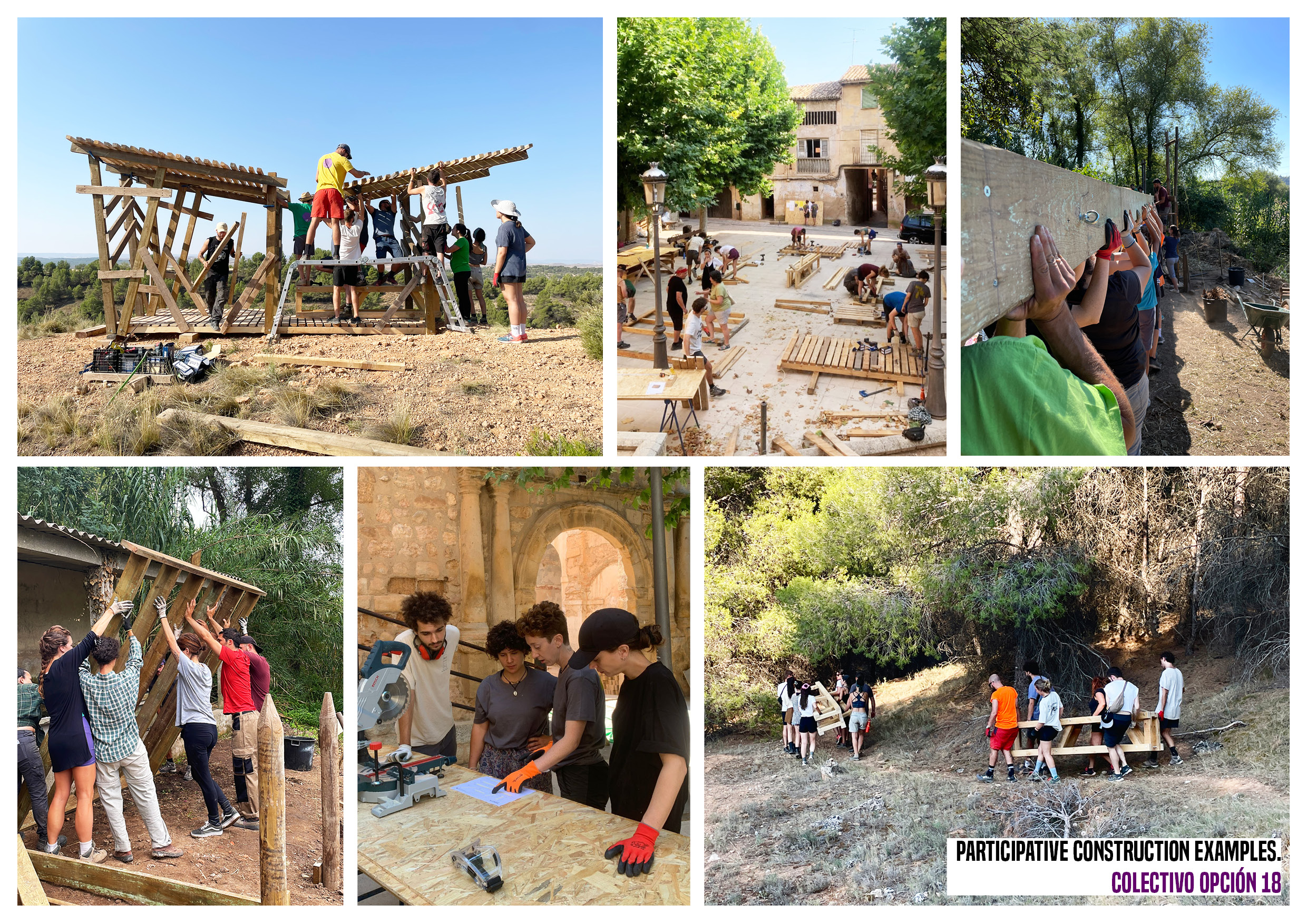Photovoltaic shading for multipurpose pa
Photovoltaic shading for multipurpose parking lot
Clean energy, convenient parking space, a more enjoyable place for community gatherings outdoors, and avoiding spoiling untouched landscapes: we aim for all this with our solar panel shading installation! It will be placed in a plot just outside Almócita town centre, serving as a parking lot and a more appropriate location for the village's weekly farmers market. It will also support the development of the energy community EcoAlmócita, which ensures a fair energy transition in the municipality.
Spain
{Empty}
Early initiative
Yes
Yes
Yes
No
No
04014: Almócita (ES)
The project aims to enhance Almócita’s infrastructure and sustainability by increasing parking availability, expanding photovoltaic capacity for the local energy community, and improving the location of the weekly farmers market, all through a participative building process.
The energy community EcoAlmócita, established in 2022, is a culmination of years of dedication to sustainability, resilience, and rural development. Through participatory democracy and community meetings, it was decided to distribute part of the energy generated by the municipal photovoltaic installations to the neighbors.
The project benefits the entire population of Almócita, with a particular focus on elderly individuals and low-income families, aiming to alleviate energy poverty and promote equitable access to clean energy. Additionally, it supports the convenience of the car-free town center with adequate nearby parking. It also provides local producers and consumers with a more suitable space for the weekly farmers market, which currently operates in an inadequate location with limited facilities.
The specific objectives we aim for are:
- Foster community empowerment through participatory planning and construction.
- Utilize an underused plot of land to maximize its potential for communal benefit.
- Address the shortage of parking spaces.
- Increase the photovoltaic capacity of EcoAlmócita, advancing self-sufficiency and a fair, sustainable energy transition, particularly for vulnerable households.
- Enhance the farmers' market by providing a dedicated, functional space that supports local producers, community cohesion, and food sovereignty.
As outcomes, we expect a multifunctional parking area that serves as a hub for community events, including the weekly farmers market, and a higher percentage of clean, affordable energy for residents. This project will strengthen Almócita’s commitment to sustainability and empower its community.
The energy community EcoAlmócita, established in 2022, is a culmination of years of dedication to sustainability, resilience, and rural development. Through participatory democracy and community meetings, it was decided to distribute part of the energy generated by the municipal photovoltaic installations to the neighbors.
The project benefits the entire population of Almócita, with a particular focus on elderly individuals and low-income families, aiming to alleviate energy poverty and promote equitable access to clean energy. Additionally, it supports the convenience of the car-free town center with adequate nearby parking. It also provides local producers and consumers with a more suitable space for the weekly farmers market, which currently operates in an inadequate location with limited facilities.
The specific objectives we aim for are:
- Foster community empowerment through participatory planning and construction.
- Utilize an underused plot of land to maximize its potential for communal benefit.
- Address the shortage of parking spaces.
- Increase the photovoltaic capacity of EcoAlmócita, advancing self-sufficiency and a fair, sustainable energy transition, particularly for vulnerable households.
- Enhance the farmers' market by providing a dedicated, functional space that supports local producers, community cohesion, and food sovereignty.
As outcomes, we expect a multifunctional parking area that serves as a hub for community events, including the weekly farmers market, and a higher percentage of clean, affordable energy for residents. This project will strengthen Almócita’s commitment to sustainability and empower its community.
Sustainability
Participation
Comunity
Energy
Equity
The initiative prioritizes sustainability through several key objectives. First, it accelerates the transition to clean energy by expanding photovoltaic capacity and strengthening the energy community EcoAlmócita. This ensures equitable access to affordable renewable energy reducing reliance on fossil fuels. At the same time, the placement of solar panels as part of a structure with other purposes and in an already-altered landscape avoids their placement in unspoiled environments, preserving those ecosystems.
Additionally, the project provides a functional space to support the weekly farmers market. This market, where most of the produce is ecologically grown, promotes and facilitates food sovereignty in the area and carries out an important work of dissemination around sustainable food systems.
The initiative also exemplifies sustainable construction practices. The entire structure will be designed for ease of disassembly, using bolted joints and reversible ‘dry’ construction methods such as hollow core slabs and screw foundations. These techniques, commonly used in solar field installations, ensure minimal environmental disruption and adaptability for future needs.
By integrating renewable energy, sustainable land use, local food systems, and eco-conscious construction, the project serves as a replicable model for rural communities striving for environmental, social, and economic sustainability.
Additionally, the project provides a functional space to support the weekly farmers market. This market, where most of the produce is ecologically grown, promotes and facilitates food sovereignty in the area and carries out an important work of dissemination around sustainable food systems.
The initiative also exemplifies sustainable construction practices. The entire structure will be designed for ease of disassembly, using bolted joints and reversible ‘dry’ construction methods such as hollow core slabs and screw foundations. These techniques, commonly used in solar field installations, ensure minimal environmental disruption and adaptability for future needs.
By integrating renewable energy, sustainable land use, local food systems, and eco-conscious construction, the project serves as a replicable model for rural communities striving for environmental, social, and economic sustainability.
The design incorporates vegetation to improve the area’s aesthetics and lower the temperatures. Along with that, the solar panel structure will provide a shaded area, offering relief from the sun while generating clean energy, making the space both practical and enjoyable. We are located in southern Spain, in an area at the frontline of desertification, where intense solar radiation makes shaded spaces essential for comfort and usability.
The participatory building process strengthens community bonds and fosters cultural exchange, as residents collaborate on the project’s design and implementation. This approach not only empowers the community but also ensures the space reflects their needs and values.
The decision to transform the area into a multifunctional space—combining parking, solar energy generation, and the weekly farmers market—was made through Almócita’s participatory democracy model. Regular community forums allow neighbors to discuss and decide on important issues, reinforcing citizen participation as a core value of the village. This inclusive process ensures the project is deeply rooted in the community’s identity and serves as a model for how democratic decision-making can shape sustainable, people-centered design.
By blending functionality, aesthetics, and community engagement, the initiative exemplifies how thoughtful design can enhance quality of life, foster positive emotions, and celebrate cultural values.
The participatory building process strengthens community bonds and fosters cultural exchange, as residents collaborate on the project’s design and implementation. This approach not only empowers the community but also ensures the space reflects their needs and values.
The decision to transform the area into a multifunctional space—combining parking, solar energy generation, and the weekly farmers market—was made through Almócita’s participatory democracy model. Regular community forums allow neighbors to discuss and decide on important issues, reinforcing citizen participation as a core value of the village. This inclusive process ensures the project is deeply rooted in the community’s identity and serves as a model for how democratic decision-making can shape sustainable, people-centered design.
By blending functionality, aesthetics, and community engagement, the initiative exemplifies how thoughtful design can enhance quality of life, foster positive emotions, and celebrate cultural values.
A core value of the energy community EcoAlmócita is combating energy poverty and ensuring inclusivity, particularly for vulnerable groups such as the elderly, who make up a significant portion of the village population. By setting the contribution to the energy community at just 20 euros per household, the initiative guarantees affordability, enabling every family to participate regardless of their economic situation.
The decision-making process for the new facilities on the underused plot exemplifies inclusive governance. Through regular open participation forums organized by the town council, residents collectively discuss and decide on important village matters. This participatory democracy model ensures that the project reflects the needs and voices of the entire community, reinforcing Almócita’s commitment to citizen engagement and shared decision-making.
Furthermore, the initiative promotes new societal models centered on fairness, sustainability, and decentralization. The farmers market and the energy community are prime examples of this shift. The market supports local producers, fosters food sovereignty, and strengthens community ties, while the energy community empowers residents to take control of their energy production and consumption.
Participatory building, in turn, is an inclusive building model that welcomes anyone interested in building and being part of the project. Its design is based on simplicity and adaptability both to the resources available in the area and to the participants, regardless of their knowledge of construction, age or motor skills. Graphic materials are produced based on assembly and safety sheets (explanatory drawings of assembly) that democratises the technical language of architecture, bringing it closer to the citizens. This methodology makes it accessible, as most of it is built at ground level and reinforces local identity and belonging.
The decision-making process for the new facilities on the underused plot exemplifies inclusive governance. Through regular open participation forums organized by the town council, residents collectively discuss and decide on important village matters. This participatory democracy model ensures that the project reflects the needs and voices of the entire community, reinforcing Almócita’s commitment to citizen engagement and shared decision-making.
Furthermore, the initiative promotes new societal models centered on fairness, sustainability, and decentralization. The farmers market and the energy community are prime examples of this shift. The market supports local producers, fosters food sovereignty, and strengthens community ties, while the energy community empowers residents to take control of their energy production and consumption.
Participatory building, in turn, is an inclusive building model that welcomes anyone interested in building and being part of the project. Its design is based on simplicity and adaptability both to the resources available in the area and to the participants, regardless of their knowledge of construction, age or motor skills. Graphic materials are produced based on assembly and safety sheets (explanatory drawings of assembly) that democratises the technical language of architecture, bringing it closer to the citizens. This methodology makes it accessible, as most of it is built at ground level and reinforces local identity and belonging.
The initiative is based on citizen participation at several levels, ensuring that those benefiting from or affected by the project are actively involved in its development and implementation. From the outset, the decision to create a photovoltaic-shaded multi-use parking lot was made through Almócita’s participatory democracy model. Regular open forums, organized by the town council, allow residents to discuss and decide on important village matters. This inclusive process ensured that the project reflects the community’s needs and priorities, fostering a sense of ownership and collective responsibility.
The construction process will further strengthen citizen involvement by being participatory. Residents will have the opportunity to contribute to the building phase, promoting collaboration, skill-sharing, and community bonding. This hands-on engagement not only empowers individuals but also ensures that the final outcome aligns with the community’s vision and values. Also, it is a great opportunity for the dissemination of basic building skills, pushing towards empowerment and gender equity.
Integrating residents’ perspectives and expertise, the initiative becomes more responsive to local needs, enhancing its functionality and relevance. The participatory approach also builds trust, strengthens social cohesion, and fosters a culture of active citizenship. Furthermore, it ensures that the project is sustainable not only environmentally but also socially, as it is rooted in the community’s collective effort and commitment.
The construction process will further strengthen citizen involvement by being participatory. Residents will have the opportunity to contribute to the building phase, promoting collaboration, skill-sharing, and community bonding. This hands-on engagement not only empowers individuals but also ensures that the final outcome aligns with the community’s vision and values. Also, it is a great opportunity for the dissemination of basic building skills, pushing towards empowerment and gender equity.
Integrating residents’ perspectives and expertise, the initiative becomes more responsive to local needs, enhancing its functionality and relevance. The participatory approach also builds trust, strengthens social cohesion, and fosters a culture of active citizenship. Furthermore, it ensures that the project is sustainable not only environmentally but also socially, as it is rooted in the community’s collective effort and commitment.
The project engages stakeholders at multiple levels, ensuring a collaborative and inclusive approach to its design and implementation. At the local level, the town council, the energy community EcoAlmócita, and the neighbors of the village are central to the project. All these stakeholders have participated in making the decisions and getting the project started. Even in the construction of the structure, the local community has an important role as they participate directly through open building workshops.
At the regional and national level, a national photovoltaic installation company, already involved in building a solar plant on municipal land, has committed to supporting village improvements as part of their land contract. Their expected financial contribution will help fund the project, bridging local needs with national expertise in renewable energy.
Colectivo Opción 18, an architecture collective, is engaged to design the project, ensuring it is functional, aesthetically pleasing, aligned with sustainable construction principles, and following a participatory process for its construction. Their involvement guarantees a high-quality outcome that balances technical requirements with community aspirations.
Additionally, EcoAlmócita is part of various regional and European networks and associations focused on renewable energy, sustainability, and rural development. These connections provide access to knowledge, best practices, and potential funding opportunities, amplifying the initiative’s impact and reach. By engaging stakeholders at local, regional, national, and European levels, the initiative benefits from diverse expertise, resources, and perspectives. This multi-level collaboration ensures the project is not only locally rooted but also connected to broader efforts in sustainability and community development, making it a replicable model for other contexts.
At the regional and national level, a national photovoltaic installation company, already involved in building a solar plant on municipal land, has committed to supporting village improvements as part of their land contract. Their expected financial contribution will help fund the project, bridging local needs with national expertise in renewable energy.
Colectivo Opción 18, an architecture collective, is engaged to design the project, ensuring it is functional, aesthetically pleasing, aligned with sustainable construction principles, and following a participatory process for its construction. Their involvement guarantees a high-quality outcome that balances technical requirements with community aspirations.
Additionally, EcoAlmócita is part of various regional and European networks and associations focused on renewable energy, sustainability, and rural development. These connections provide access to knowledge, best practices, and potential funding opportunities, amplifying the initiative’s impact and reach. By engaging stakeholders at local, regional, national, and European levels, the initiative benefits from diverse expertise, resources, and perspectives. This multi-level collaboration ensures the project is not only locally rooted but also connected to broader efforts in sustainability and community development, making it a replicable model for other contexts.
The initiative integrates fields such as renewable energy engineering, sustainable and participatory architecture, participatory governance, and community development. The design and implementation process has involved collaboration between representatives from these fields, each contributing to create a holistic and impactful project.
The energy community EcoAlmócita, with its focus on renewable energy and sustainability, drives the transition to clean energy, ensuring the project aligns with environmental goals. The architecture collective Opción 18 works following sustainable design principles, ensuring the structure is functional, aesthetically pleasing, and built using eco-friendly materials and methods, such as reversible ‘dry’ construction techniques.
Participatory governance is central to the initiative, with the town council and neighbors engaging in open forums to collectively decide on the project’s scope and design. The participatory building process further strengthens this approach, allowing residents to contribute to the construction, promoting skill-sharing and community bonding. This combination fosters a sense of ownership and shared responsibility
The transformation of an underused plot into a multifunctional space—combining parking, solar energy generation, and a farmers market—demonstrates innovative land use and urban planning. This approach not only maximizes the plot’s utility but also supports local food sovereignty and community resilience.
The interaction between these disciplines adds significant value to the initiative. By combining technical expertise with community insights, the project balances functionality, sustainability, and social impact. This collaborative process ensures the initiative is not only technically sound but also deeply rooted in the community’s identity and aspirations, making it a replicable model for other contexts.
The energy community EcoAlmócita, with its focus on renewable energy and sustainability, drives the transition to clean energy, ensuring the project aligns with environmental goals. The architecture collective Opción 18 works following sustainable design principles, ensuring the structure is functional, aesthetically pleasing, and built using eco-friendly materials and methods, such as reversible ‘dry’ construction techniques.
Participatory governance is central to the initiative, with the town council and neighbors engaging in open forums to collectively decide on the project’s scope and design. The participatory building process further strengthens this approach, allowing residents to contribute to the construction, promoting skill-sharing and community bonding. This combination fosters a sense of ownership and shared responsibility
The transformation of an underused plot into a multifunctional space—combining parking, solar energy generation, and a farmers market—demonstrates innovative land use and urban planning. This approach not only maximizes the plot’s utility but also supports local food sovereignty and community resilience.
The interaction between these disciplines adds significant value to the initiative. By combining technical expertise with community insights, the project balances functionality, sustainability, and social impact. This collaborative process ensures the initiative is not only technically sound but also deeply rooted in the community’s identity and aspirations, making it a replicable model for other contexts.
One of its key innovations is the combined use of solar energy and shaded parking. The project features a wooden structure with a photovoltaic roof that not only generates clean energy but also provides shade for vehicles—a feature rarely seen in conventional parking lots. While many solar installations focus solely on energy production, this initiative integrates sustainability with user comfort.
Another innovative aspect is the integration of the farmers' market within the same space. By temporarily removing cars and setting up stalls for local producers, the project promotes renewable energy while fostering local commerce, supporting the circular economy, and reducing footprints. This dual-purpose approach transforms the space into a hub for sustainable living and community interaction.
The participatory building process further sets the project apart. Unlike traditional projects, which are often carried out by external companies, this initiative actively involves the local community. This inclusive approach not only fosters a sense of ownership and belonging but also strengthens social cohesion, making the project a true reflection of collective effort and shared values.
Additionally, the initiative creatively repurposes an underused plot of land, transforming it into a multifunctional space that benefits both the community and the environment. Turning vacant areas into useful, sustainable infrastructures, the project demonstrates how urban spaces can be reimagined to address contemporary challenges.
Finally, the initiative’s integration of renewable energy into daily life is particularly innovative. Rather than focusing solely on energy generation, it directly impacts the community by providing tangible benefits: shaded parking, a vibrant market space, affordable clean energy, etc. This holistic approach contrasts with conventional projects, which often address only one aspect of sustainable development.
Another innovative aspect is the integration of the farmers' market within the same space. By temporarily removing cars and setting up stalls for local producers, the project promotes renewable energy while fostering local commerce, supporting the circular economy, and reducing footprints. This dual-purpose approach transforms the space into a hub for sustainable living and community interaction.
The participatory building process further sets the project apart. Unlike traditional projects, which are often carried out by external companies, this initiative actively involves the local community. This inclusive approach not only fosters a sense of ownership and belonging but also strengthens social cohesion, making the project a true reflection of collective effort and shared values.
Additionally, the initiative creatively repurposes an underused plot of land, transforming it into a multifunctional space that benefits both the community and the environment. Turning vacant areas into useful, sustainable infrastructures, the project demonstrates how urban spaces can be reimagined to address contemporary challenges.
Finally, the initiative’s integration of renewable energy into daily life is particularly innovative. Rather than focusing solely on energy generation, it directly impacts the community by providing tangible benefits: shaded parking, a vibrant market space, affordable clean energy, etc. This holistic approach contrasts with conventional projects, which often address only one aspect of sustainable development.
The methodology used in this project is based on two fundamental fields: inclusion and citizen participation, and public-private collaboration.
In terms of citizen participation, two stages can be distinguished. The first consists of the project's development, from the creation of the EcoAlmócita energy community to the actual design of the solar roof. Throughout the process, the project is kept open through community sessions in which needs are discussed and solutions are proposed collaboratively. In these sessions, different points are dealt with, depending on the phase of the project.
The second phase focuses on the actual execution of the structure: the participatory building process, where anyone interested in building and sharing is welcome. The project is designed considering the inclusion of non-professionals in construction, which is achieved through the prefabrication of simple, modular, repeatable parts. Also, assembly instructions (similar to ‘how to assemble a piece of furniture’) are provided, democratizing the technical language of architecture. Prefabrication makes it possible to build on level 0 safely and inclusively with children (linking it with the school community), people with reduced mobility or disabilities, the elderly, etc.
This participatory process encourages the involvement of people in the physical materialization of the projects, giving citizens the ability to ‘make neighborhood’ with their own hands, fostering collective empowerment, strengthening social cohesion and promoting a closer and more humane architecture.
Concerning public-private collaboration, teamwork between public entities and the private sector (whether associations or companies) is considered fundamental, addressing common objectives of collective benefit. In this sense, the project is developed by the Almócita town council, designed by Colectivo Opción 18 and the photovoltaic company and executed by the residents, to be used and enjoyed by everyone.
In terms of citizen participation, two stages can be distinguished. The first consists of the project's development, from the creation of the EcoAlmócita energy community to the actual design of the solar roof. Throughout the process, the project is kept open through community sessions in which needs are discussed and solutions are proposed collaboratively. In these sessions, different points are dealt with, depending on the phase of the project.
The second phase focuses on the actual execution of the structure: the participatory building process, where anyone interested in building and sharing is welcome. The project is designed considering the inclusion of non-professionals in construction, which is achieved through the prefabrication of simple, modular, repeatable parts. Also, assembly instructions (similar to ‘how to assemble a piece of furniture’) are provided, democratizing the technical language of architecture. Prefabrication makes it possible to build on level 0 safely and inclusively with children (linking it with the school community), people with reduced mobility or disabilities, the elderly, etc.
This participatory process encourages the involvement of people in the physical materialization of the projects, giving citizens the ability to ‘make neighborhood’ with their own hands, fostering collective empowerment, strengthening social cohesion and promoting a closer and more humane architecture.
Concerning public-private collaboration, teamwork between public entities and the private sector (whether associations or companies) is considered fundamental, addressing common objectives of collective benefit. In this sense, the project is developed by the Almócita town council, designed by Colectivo Opción 18 and the photovoltaic company and executed by the residents, to be used and enjoyed by everyone.
The initiative incorporates several elements that are highly replicable and adaptable to other contexts, making it a valuable model for communities worldwide:
- Simple and scalable design. The structure of the photovoltaic shading for a multi-use parking lot is straightforward and cost-effective, ensuring it can be easily replicated in other locations. Its modular design allows for customization based on local needs and available resources.
- Participatory decision-making. The participatory democracy model used in Almócita—where residents collectively discuss and decide on projects through open forums—is a transferable process. While it requires time and intention, it fosters inclusivity, ownership, and community buy-in, making it adaptable to diverse groups and contexts.
- Participatory building methodology. The hands-on, community-focused construction process is another replicable aspect. This approach can be applied to other projects, regardless of scale or complexity, and can accommodate varying levels of participant skill and ability. It promotes collaboration, skill-sharing, and empowerment, strengthening community bonds.
- Multipurpose photovoltaic installations. The concept of combining solar energy generation with shaded, multipurpose spaces (e.g., parking lots, markets, or recreational areas) is a versatile solution. It supports the transition to clean energy while minimizing environmental impact by utilizing already altered landscapes, avoiding the need to disrupt untouched natural areas.
- Integration of local values. The initiative demonstrates how projects can align with and reinforce local values, such as sustainability, equity, and community participation. This approach can inspire other communities to develop solutions that reflect their unique cultural and social priorities.
- Simple and scalable design. The structure of the photovoltaic shading for a multi-use parking lot is straightforward and cost-effective, ensuring it can be easily replicated in other locations. Its modular design allows for customization based on local needs and available resources.
- Participatory decision-making. The participatory democracy model used in Almócita—where residents collectively discuss and decide on projects through open forums—is a transferable process. While it requires time and intention, it fosters inclusivity, ownership, and community buy-in, making it adaptable to diverse groups and contexts.
- Participatory building methodology. The hands-on, community-focused construction process is another replicable aspect. This approach can be applied to other projects, regardless of scale or complexity, and can accommodate varying levels of participant skill and ability. It promotes collaboration, skill-sharing, and empowerment, strengthening community bonds.
- Multipurpose photovoltaic installations. The concept of combining solar energy generation with shaded, multipurpose spaces (e.g., parking lots, markets, or recreational areas) is a versatile solution. It supports the transition to clean energy while minimizing environmental impact by utilizing already altered landscapes, avoiding the need to disrupt untouched natural areas.
- Integration of local values. The initiative demonstrates how projects can align with and reinforce local values, such as sustainability, equity, and community participation. This approach can inspire other communities to develop solutions that reflect their unique cultural and social priorities.
The project addresses several global challenges through local solutions:
- Climate change and energy transition. The initiative contributes to reducing greenhouse gas emissions and advancing the global transition to renewable energy. It demonstrates how decentralized, community-driven energy systems can be realistic alternatives.
- Energy poverty. The project tackles energy poverty by ensuring affordable access to clean energy for all residents, particularly vulnerable groups such as the elderly and low-income families. This local approach offers a replicable model for addressing energy inequality.
- Sustainable land use. By installing solar panels in areas already altered by human activity, the initiative avoids disrupting untouched landscapes, aligning with global efforts to balance renewable energy development with environmental preservation.
- Rural depopulation. The project strengthens Almócita’s appeal as a place to live by improving quality of life, fostering community engagement, and creating sustainable infrastructure. All these are key parts for addressing rural depopulation, a critical challenge in many regions across Europe and worldwide.
- Food sovereignty and local economies. The improved market space supports local producers, promotes food sovereignty, and reduces the footprint associated with the food system, strengthening local economies and aligning with global goals for sustainable agriculture and community resilience.
- Participatory democracy and social inclusion. The initiative reinforces participatory decision-making and inclusive governance, addressing global challenges related to social equity and democratic engagement.
- Sustainable urban development. The multifunctional design of the photovoltaic shading for the parking lot integrates clean energy, community space, and practical infrastructure, offering a model for sustainable urban and rural development including functionality, aesthetics, and environmental care.
- Climate change and energy transition. The initiative contributes to reducing greenhouse gas emissions and advancing the global transition to renewable energy. It demonstrates how decentralized, community-driven energy systems can be realistic alternatives.
- Energy poverty. The project tackles energy poverty by ensuring affordable access to clean energy for all residents, particularly vulnerable groups such as the elderly and low-income families. This local approach offers a replicable model for addressing energy inequality.
- Sustainable land use. By installing solar panels in areas already altered by human activity, the initiative avoids disrupting untouched landscapes, aligning with global efforts to balance renewable energy development with environmental preservation.
- Rural depopulation. The project strengthens Almócita’s appeal as a place to live by improving quality of life, fostering community engagement, and creating sustainable infrastructure. All these are key parts for addressing rural depopulation, a critical challenge in many regions across Europe and worldwide.
- Food sovereignty and local economies. The improved market space supports local producers, promotes food sovereignty, and reduces the footprint associated with the food system, strengthening local economies and aligning with global goals for sustainable agriculture and community resilience.
- Participatory democracy and social inclusion. The initiative reinforces participatory decision-making and inclusive governance, addressing global challenges related to social equity and democratic engagement.
- Sustainable urban development. The multifunctional design of the photovoltaic shading for the parking lot integrates clean energy, community space, and practical infrastructure, offering a model for sustainable urban and rural development including functionality, aesthetics, and environmental care.
The intention is to ensure the long-term sustainability and impact of the project. Therefore the roadmap of the initiative includes both a short and a long-term vision.
The project's construction phase is planned for between September 2025 and May 2026, carried out by Colectivo Opción 18. This phase includes the search for reusable or local materials, aiming to have the smallest possible footprint in the materials' resourcing. The construction encompasses as well the participatory building process and sharing and celebration spaces. This way we place the neighbors and their needs at the center, making the experience accessible and enriching for everyone. For the photovoltaic installation, we already have an agreement with a company that is carrying out another project in the area and will fund and take charge of the solar panels.
In the longer term, after the finalization of the installation, maintenance works will be carried out when necessary, along with continuous communication with the users to adapt to the situation of the farmers' market and other possible activities. When it is operative, the idea is to promote activities that can take advantage of the new facilities.
In terms of the energy community EcoAlmócita, the next steps are related to unifying the different photovoltaic installations and preparing the infrastructure for better management and distribution of the energy. It is also planned to organize community purchases of energy efficiency-related items and to have solar panels directly owned by them.
Zooming out the scene, the idea in the long term is to have the energy community as a solvent cooperative that can support other projects aligned with the values of sustainability, accessibility and inclusivity. An example of those projects is the idea of future cohousing in the village, which would allow elderly people who cannot live alone anymore to stay in their village and community while being taken care of.
The project's construction phase is planned for between September 2025 and May 2026, carried out by Colectivo Opción 18. This phase includes the search for reusable or local materials, aiming to have the smallest possible footprint in the materials' resourcing. The construction encompasses as well the participatory building process and sharing and celebration spaces. This way we place the neighbors and their needs at the center, making the experience accessible and enriching for everyone. For the photovoltaic installation, we already have an agreement with a company that is carrying out another project in the area and will fund and take charge of the solar panels.
In the longer term, after the finalization of the installation, maintenance works will be carried out when necessary, along with continuous communication with the users to adapt to the situation of the farmers' market and other possible activities. When it is operative, the idea is to promote activities that can take advantage of the new facilities.
In terms of the energy community EcoAlmócita, the next steps are related to unifying the different photovoltaic installations and preparing the infrastructure for better management and distribution of the energy. It is also planned to organize community purchases of energy efficiency-related items and to have solar panels directly owned by them.
Zooming out the scene, the idea in the long term is to have the energy community as a solvent cooperative that can support other projects aligned with the values of sustainability, accessibility and inclusivity. An example of those projects is the idea of future cohousing in the village, which would allow elderly people who cannot live alone anymore to stay in their village and community while being taken care of.

